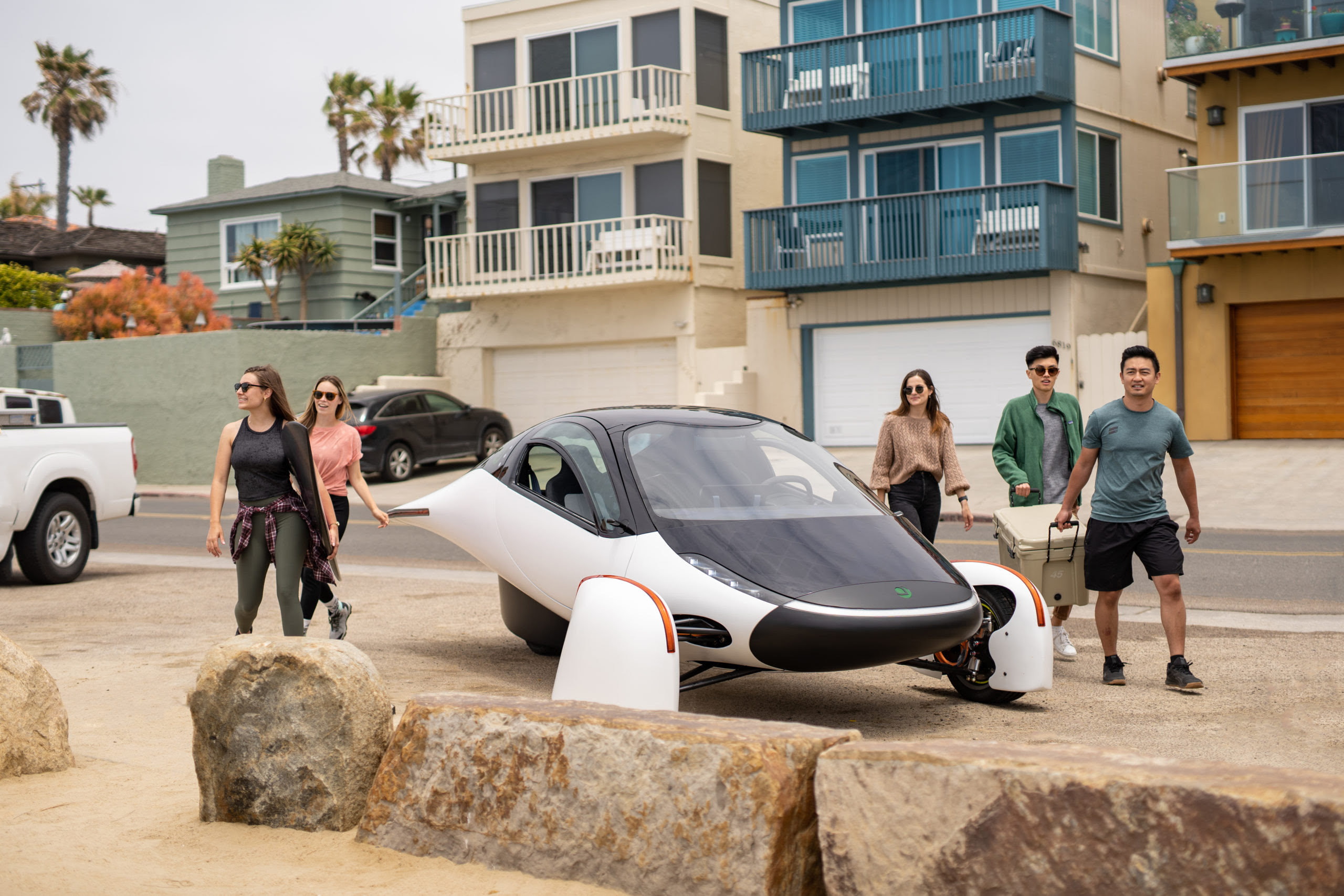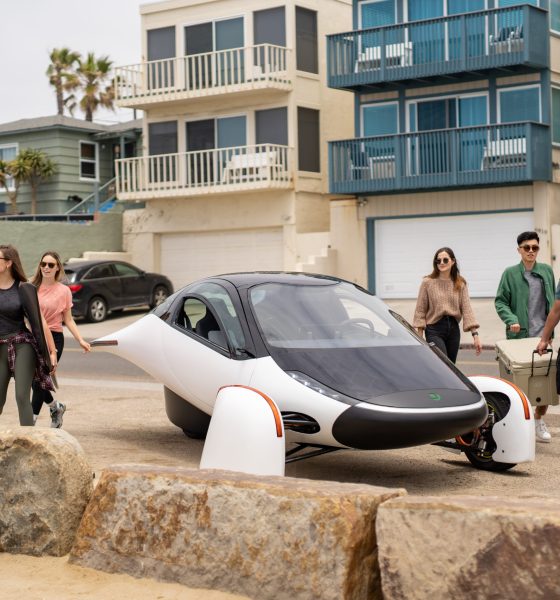Aptera has announced that they will be using EVE Energy batteries in their upcoming production car, and the batteries will be produced in San Diego.
As Aptera has moved ever closer to being ready for production, they have been making agreements with several companies who will be supplying their production run, including setting up an agreement with Elaphe Motors for producing in-hub motors in Slovakia. Today, they have announced yet another partnership, this time with EVE Energy, a Chinese battery manufacturer who will be supplying Aptera with batteries made in a San Diego production facility.
Specifically, Aptera has chosen to use EVE’s 21700 NMC 811 cylindrical lithium-ion batteries in its structural battery packs. Aptera Co-CEO Chris Anthony stated, “The decision to move forward with lithium-ion 21700 NMC 811 cylindrical cells enables us to maximize efficiency in Aptera capable of over 1,000 miles of range per charge. As we continue to drive solar mobility forward by designing the most efficient vehicles, this partnership with EVE Energy represents all that our team has accomplished.”
NMC — or Nickel, Manganese, and Cobalt cells — have a high energy density and have been less popular than LFP batteries — or Lithium Iron Phosphate — in recent times. LFP cells utilize more widely available materials due to Tesla’s reputation as a mass-production automaker.
EVE produces a wider range of battery cells, which include Lithium Primary batteries, Li-ion rechargeable Pouch cells, 18650/21700/46950 series cylindrical cells, and large format prismatic LFP/NMC cells. Tesla fans will recognize 18650 and 21700, as those cell formats are utilized in the Model S and Model X, and Model 3 and Model Y, respectively. Tesla is also transitioning Model Y vehicles to the 4680 cell format at Gigafactory Texas.
- Credit: Aptera
- Aptera Luna prototype vehicle (Credit: Aptera)
Anthony goes on to state that efficiency is achieved through the battery’s lightweight design and high energy density.
Looking at the EVE website, the battery is not specifically listed, however, two other batteries are listed similarly. The EVE INR21700/50E and EVE INR21700/40P were the closest to what Aptera described, and EVE advertises the battery’s quick charging time, which will provide 70 percent of range in around 20 minutes, safety, and performance under poor temperature conditions.
EVE is based out of China, but has over 20 offices worldwide, including a Sales office in the United States, and a distribution base in Canada.
For a vehicle like Aptera that claims to be able to be used all year, this will be key in ensuring the best possible experience for customers in poor climate conditions.
Still, no news has been released from Aptera on if they will be able to use the Tesla Connector on their upcoming production vehicle, but many have seemed hopeful that the company’s widely-used charger ,and perhaps charging network, could make its way onto the startup’s vehicle.
What do you think of the article? Do you have any comments, questions, or concerns? Shoot me an email at william@teslarati.com. You can also reach me on Twitter @WilliamWritin. If you have news tips, email us at tips@teslarati.com!

News
Tesla China quietly posts Robotaxi-related job listing
Tesla China is currently seeking a Low Voltage Electrical Engineer to work on circuit board design for the company’s autonomous vehicles.

Tesla has posted a new job listing in Shanghai explicitly tied to its Robotaxi program, fueling speculation that the company is preparing to launch its dedicated autonomous ride-hailing service in China.
As noted in the listing, Tesla China is currently seeking a Low Voltage Electrical Engineer to work on circuit board design for the company’s autonomous vehicles.
Robotaxi-specific role
The listing, which was shared on social media platform X by industry watcher @tslaming, suggested that Tesla China is looking to fill the role urgently. The job listing itself specifically mentions that the person hired for the role will be working on the Low Voltage Hardware team, which would design the circuit boards that would serve as the nervous system of the Robotaxi.
Key tasks for the role, as indicated in the job listing, include collaboration with PCB layout, firmware, mechanical, program management, and validation teams, among other responsibilities. The role is based in Shanghai.
China Robotaxi launch
China represents a massive potential market for robotaxis, with its dense urban centers and supportive policies in select cities. Tesla has limited permission to roll out FSD in the country, though despite this, its vehicles have been hailed as among the best in the market when it comes to autonomous features. So far, at least, it appears that China supports Tesla’s FSD and Robotaxi rollout.
This was hinted at in November, when Tesla brought the Cybercab to the 8th China International Import Expo (CIIE) in Shanghai, marking the first time that the autonomous two-seater was brought to the Asia-Pacific region. The vehicle, despite not having a release date in China, received a significant amount of interest among the event’s attendees.
Elon Musk
Elon Musk and Tesla AI Director share insights after empty driver seat Robotaxi rides
The executives’ unoccupied tests hint at the rapid progress of Tesla’s unsupervised Robotaxi efforts.

Tesla CEO Elon Musk and AI Director Ashok Elluswamy celebrated Christmas Eve by sharing personal experiences with Robotaxi vehicles that had no safety monitor or occupant in the driver’s seat. Musk described the system’s “perfect driving” around Austin, while Elluswamy posted video from the back seat, calling it “an amazing experience.”
The executives’ unoccupied tests hint at the rapid progress of Tesla’s unsupervised Robotaxi efforts.
Elon and Ashok’s firsthand Robotaxi insights
Prior to Musk and the Tesla AI Director’s posts, sightings of unmanned Teslas navigating public roads were widely shared on social media. One such vehicle was spotted in Austin, Texas, which Elon Musk acknowleged by stating that “Testing is underway with no occupants in the car.”
Based on his Christmas Eve post, Musk seemed to have tested an unmanned Tesla himself. “A Tesla with no safety monitor in the car and me sitting in the passenger seat took me all around Austin on Sunday with perfect driving,” Musk wrote in his post.
Elluswamy responded with a 2-minute video showing himself in the rear of an unmanned Tesla. The video featured the vehicle’s empty front seats, as well as its smooth handling through real-world traffic. He captioned his video with the words, “It’s an amazing experience!”
Towards Unsupervised operations
During an xAI Hackathon earlier this month, Elon Musk mentioned that Tesla owed be removing Safety Monitors from its Robotaxis in Austin in just three weeks. “Unsupervised is pretty much solved at this point. So there will be Tesla Robotaxis operating in Austin with no one in them. Not even anyone in the passenger seat in about three weeks,” he said. Musk echoed similar estimates at the 2025 Annual Shareholder Meeting and the Q3 2025 earnings call.
Considering the insights that were posted Musk and Elluswamy, it does appear that Tesla is working hard towards operating its Robotaxis with no safety monitors. This is quite impressive considering that the service was launched just earlier this year.
Elon Musk
Starlink passes 9 million active customers just weeks after hitting 8 million
The milestone highlights the accelerating growth of Starlink, which has now been adding over 20,000 new users per day.

SpaceX’s Starlink satellite internet service has continued its rapid global expansion, surpassing 9 million active customers just weeks after crossing the 8 million mark.
The milestone highlights the accelerating growth of Starlink, which has now been adding over 20,000 new users per day.
9 million customers
In a post on X, SpaceX stated that Starlink now serves over 9 million active users across 155 countries, territories, and markets. The company reached 8 million customers in early November, meaning it added roughly 1 million subscribers in under seven weeks, or about 21,275 new users on average per day.
“Starlink is connecting more than 9M active customers with high-speed internet across 155 countries, territories, and many other markets,” Starlink wrote in a post on its official X account. SpaceX President Gwynne Shotwell also celebrated the milestone on X. “A huge thank you to all of our customers and congrats to the Starlink team for such an incredible product,” she wrote.
That growth rate reflects both rising demand for broadband in underserved regions and Starlink’s expanding satellite constellation, which now includes more than 9,000 low-Earth-orbit satellites designed to deliver high-speed, low-latency internet worldwide.
Starlink’s momentum
Starlink’s momentum has been building up. SpaceX reported 4.6 million Starlink customers in December 2024, followed by 7 million by August 2025, and 8 million customers in November. Independent data also suggests Starlink usage is rising sharply, with Cloudflare reporting that global web traffic from Starlink users more than doubled in 2025, as noted in an Insider report.
Starlink’s momentum is increasingly tied to SpaceX’s broader financial outlook. Elon Musk has said the satellite network is “by far” the company’s largest revenue driver, and reports suggest SpaceX may be positioning itself for an initial public offering as soon as next year, with valuations estimated as high as $1.5 trillion. Musk has also suggested in the past that Starlink could have its own IPO in the future.












